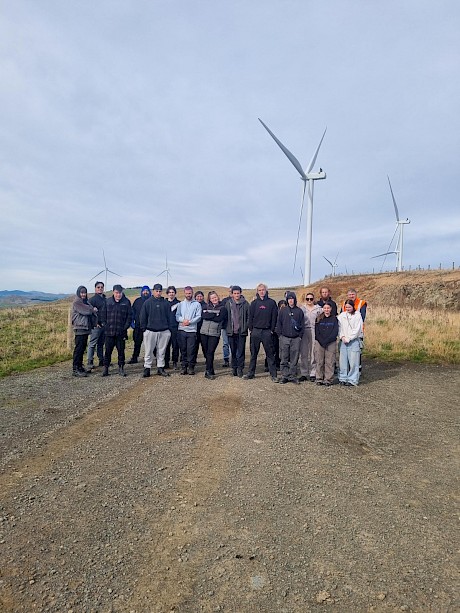Kia Tū: A foundation for what comes next
 The fourth Kia Tū Trade Training Pathway Programme at the Southern Institute of Technology (SIT) has now wrapped up, celebrating eight weeks of learning, reflection, and planning—laying the foundation for each participant’s next chapter. The course ran from March 15 to May 16, with a break in the middle around Easter and ANZAC Day.
The fourth Kia Tū Trade Training Pathway Programme at the Southern Institute of Technology (SIT) has now wrapped up, celebrating eight weeks of learning, reflection, and planning—laying the foundation for each participant’s next chapter. The course ran from March 15 to May 16, with a break in the middle around Easter and ANZAC Day.
Designed to support participants into employment, further study, or training, Kia Tū provides a mix of hands-on experiences, personalised planning, and real-world exposure.
The focus was on helping participants build confidence, explore opportunities, and develop a clear sense of direction for the road ahead. Over the eight weeks, the group worked through a structured programme that combined classroom learning with community and industry engagement.
Real-world industry insights Site visit to Mercury Energy’s wind farm at Kaiwera.
Site visit to Mercury Energy’s wind farm at Kaiwera.
A key highlight of the Kia Tū experience was getting out into the community and learning from people working in a wide range of industries. Ākonga were welcomed into workplaces across Murihiku/Southland, where they saw firsthand what different roles involve and how businesses operate.
Site visits included:
- Mercury Energy’s wind farm at Kaiwera
- Tiwai Point aluminium smelter
- Fonterra’s Edendale dairy processing plant
- Invercargill Licensing Trust venues including Langlands, Centre Point, and Waxy’s
Each visit offered a behind-the-scenes look into how industries work and opened participants’ eyes to roles they may not have previously considered.
Ākonga also explored trades workshops at the Southern Institute of Technology (SIT), gaining valuable exposure to fields like automotive, carpentry, plumbing, electrical, and engineering. These hands-on experiences helped many of our ākonga see a pathway into further training or apprenticeships.
Pathway planning and achievement
Throughout the course, each participant developed a personalised pathway plan. This process helped them identify their strengths, interests, and possible next steps into work, training, or study. As part of their Microcredential achievement, students presented their plans to the group—many doing so with confidence, clarity, and pride.
For some, it was the first time speaking in front of others. For others, it was an opportunity to articulate where they see themselves heading. These presentations were a real milestone in their personal development.
All participants who completed the programme successfully achieved their Microcredential—a formal recognition of their planning, engagement, and growth throughout Kia Tū.
Tutor reflections
The successes in this cohort were many, but a few really stood out.
One young man who had previously struggled with Kura—holding a school attendance rate of just 10–15%—thrived in the Kia Tū environment. He embraced the structure, support, and inclusive classroom culture, finishing the course with an outstanding attendance rate of over 90%.
Another standout story came from an ākonga who already held a degree in music. Unsure if he should pursue a trade or explore teaching, he used his time in the programme to gain clarity. In the end, trades weren’t for him—but the Kia Tū experience helped him decide to enrol in a teaching qualification next year.
This class also saw strong interest in electrical careers, with several participants now looking to enrol in electrical training programmes. Each Kia Tū cohort is different, but a few things remain constant: the growth in confidence, the sense of connection, the humour, and the pride our ākonga develop during their time with us.
Looking Ahead
Graduation day was a celebration—not just of finishing the programme, but of how far each individual had come. Many ākonga arrived feeling unsure about their direction or options. They left with increased confidence, greater clarity, and a realistic plan for the future.
Importantly, the support doesn’t stop here. Kia Tū continues to walk alongside its graduates as they take their next steps—whether it’s moving into employment, enrolling in study or training, or continuing to grow the life skills and mindset they’ve developed during the course.
With four successful cohorts now completed, the ripple effects of Kia Tū continue to grow—across workplaces, whānau, and the wider community.
Next Course: July 29- September 19
Applications Close: July 14
Acknowledging Our Supporters
A sincere thank you to all those who made this Kia Tū programme possible. To the employers and organisations who hosted site visits and welcomed our ākonga into their workplaces—your generosity, time, and willingness to share your experiences made a lasting impression.
Thank you also to the guest speakers who came into the classroom and shared their journeys, insights, and challenges. These conversations sparked ideas, broadened horizons, and showed what’s possible with resilience and hard work.
And finally, to our tutors and support staff—thank you for creating an environment where ākonga feel safe, encouraged, and supported. Your belief in each person helped them to believe in themselves. Your mahi is the heart of Kia Tū.
Posted: 30 May 2025
